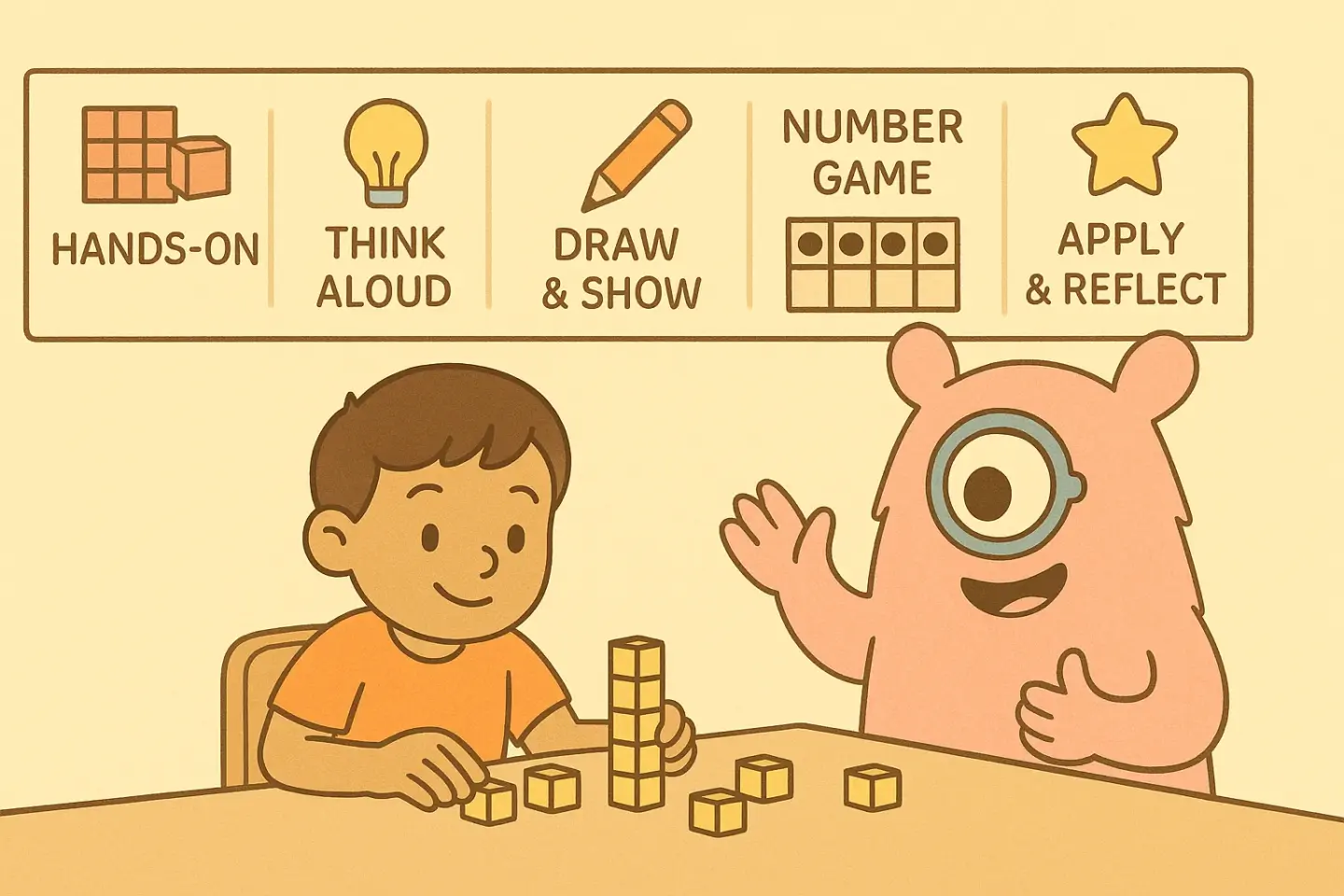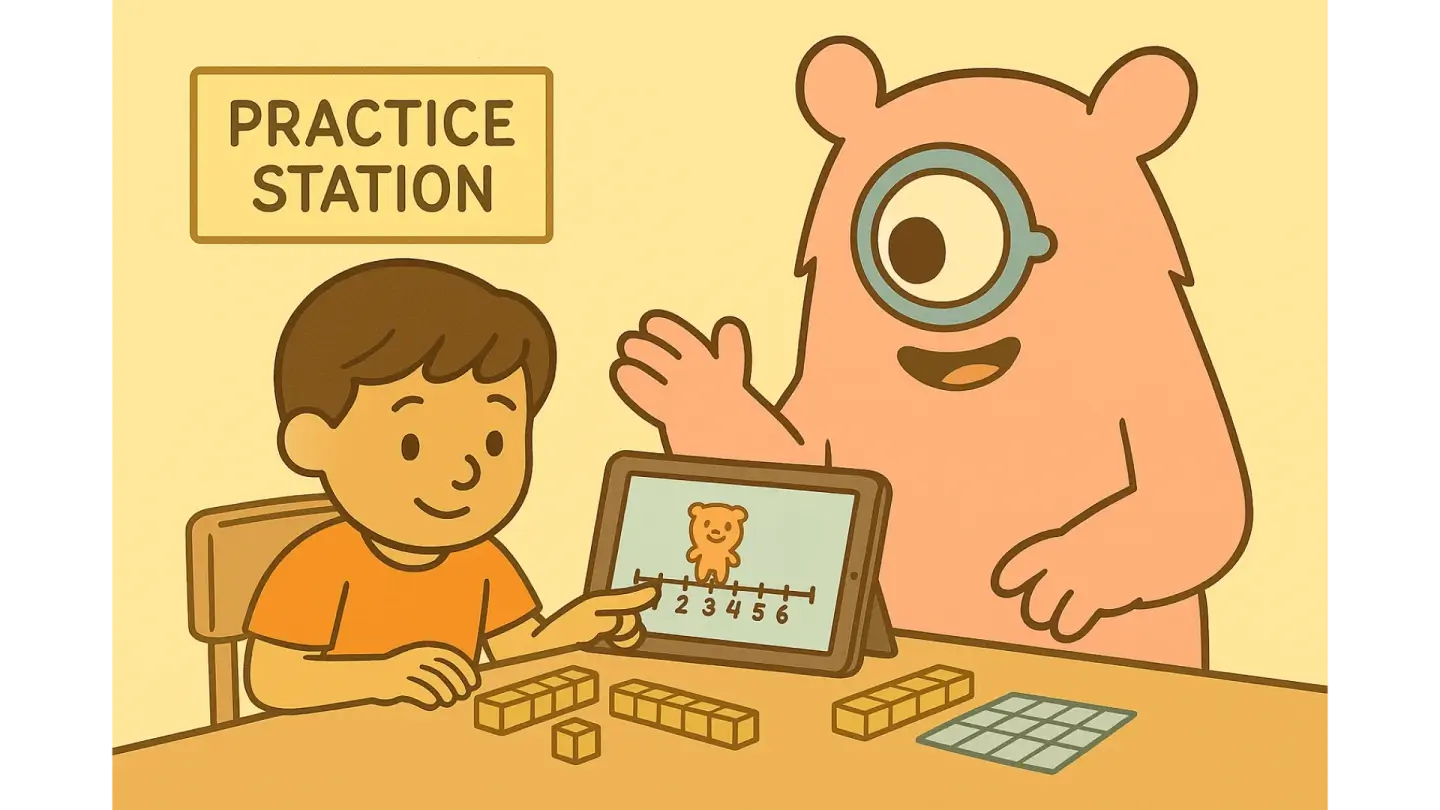Choosing a Math Curriculum for Autistic Learners: A Homeschool Parent’s Guide
TL;DR:If you’re homeschooling an autistic child, pick (or adapt) a curriculum that emphasizes visual, hands-on learning and clear, step-by-step lessons, delivered in a predictable routine. Evidence supports using the Concrete–Representational–Abstract (CRA) sequence with autistic learners, explicit instruction for new concepts, and schema-based organizers for word problems. Because symbolic number skills can be a specific pressure point, plan routine number-sense work, and use tech-supported practice when helpful.
Why the curriculum choice matters
Autistic learners often display uneven profiles: strong pattern recognition and visual thinking alongside challenges with language-heavy or multi-step tasks. A recent meta-analysis reports group-level difficulties in math for autistic students compared with neurotypical peers, underscoring the need for deliberate scaffolds and pacing. The good news is that structured, visual, and interest-connected instruction can substantially improve learning trajectories via CRA routines and explicit teaching. When a curriculum actively invites you to personalize tasks, you can align lessons with your child’s comfort, sensory needs, and motivation - turning math from a stressor into a predictable, confidence-building part of the day.

What to look for in a homeschool math curriculum
1) Concrete–Representational–Abstract (CRA) progression
Curricula that move from manipulatives (concrete), to drawings/visuals (representational), and finally to numbers and symbols (abstract) help autistic learners build durable understanding. CRA has documented benefits in autism contexts and shows positive effects in inclusive algebra settings too. When previewing a program, check that new ideas are taught with manipulatives first, and that you can step back to visuals whenever confusion appears. A simple rule of thumb: if a page is heavy on symbols, add your own objects and sketches to keep the CRA ladder intact.
2) Explicit instruction and guided practice
Autistic learners benefit when educators model thinking steps aloud, provide worked examples, and then transition to guided and independent practice with feedback. Studies show explicit instruction improves concept acquisition and generalization for students with autism. Look for short, focused lessons; clear educator prompts; and frequent checks for understanding. If your chosen curriculum is light on modeling, you can still read the example aloud, narrate your steps (“I’m regrouping a ten here because…”), and then do one problem together before asking for independent work.
3) Word-problem scaffolds (schema-based instruction)
Word problems can be tricky due to language load and distractors. Schema-based instruction teaches students to recognize problem types (e.g., part–whole, compare, change) and use a consistent visual organizer. Modified schema-based instruction has been successfully applied with autistic students to boost flexible problem solving. To make this automatic at home, keep one-page templates (drawn boxes/arrows) near your math area and fill them before any computation.
4) Systematic number-sense routines
Symbolic number skills (mapping numerals to magnitudes) can mediate math performance differences for autistic learners, pointing to the value of explicit work with quantities, numerals, and comparisons. Prefer programs that revisit subitizing, composing/decomposing numbers, ten-frames, and magnitude comparisons weekly. Ten minutes of daily number-sense warm-ups (quick ten-frame flashes, “which is bigger?” cards) often pay outsized dividends.
5) Purposeful technology supports
Well-designed tablet or app experiences can scaffold attention, sequencing, and practice when aligned to goals. Classroom studies report inclusion benefits for tablet-based supports with autistic students when used intentionally, not as a substitute for instruction. Think of tech as a practice station you rotate into - not the whole lesson - and preview apps to ensure clean visuals and adjustable settings.

6) Clean layout and predictable structure
Uncluttered pages, ample whitespace, and consistent visual cues reduce cognitive load -especially for learners sensitive to language density or visual noise. The combination of predictable routines and visual organizers is repeatedly linked to better access to math for autistic students. A daily routine also pairs well with home-friendly ideas in our article on building calm practice blocks, where we share math routines that support autistic kids so you can keep structure steady while still personalizing the day.
How to choose (and tailor) a program at home
- Start with a brief baseline. Use a few mixed problems or an informal chat to see where your child is comfortable. Plan early wins and shore up any number-sense gaps first. A quick “show me with cubes, then draw it, then write it” routine reveals where to begin.
- Check for CRA in every unit. If a workbook jumps straight to abstract symbols, add manipulatives and sketches yourself to maintain the CRA flow. Keep a small “math toolkit” (ten-frames, base-ten blocks, number line) within arm’s reach.
- Insist on explicit sequencing. Use “I do-We do-You do” with immediate feedback and short practice sets, which aligns to the explicit-instruction evidence base for autistic learners. If attention dips, switch the modality (whiteboard instead of paper) without changing the skill.
- Preteach word-problem structures. Sort problems into types and fill a visual organizer before computing, following schema-based protocols. Over time, kids learn to “spot the schema” and choose the right diagram on their own.
- Embed special interests. Re-skin problems with topics your child loves to increase attention and persistence; this strategy is widely reported to improve engagement for autistic students in STEM education research.
- Measure little and often. Use two or three exit problems and adjust pacing weekly; meta-analytic findings justify steady, scaffolded progressions for autistic learners at the group level. Keep notes on which representations “clicked” so you can reuse them.
Building a Math Routine That Works for Your Child
Rather than following a strict daily plan, think of your homeschool math time as a cycle - concrete practice → visual reasoning → application. This flexible rhythm is grounded in the well-studied Concrete–Representational–Abstract (CRA) model, which helps autistic learners connect real experiences to mathematical symbols.
Begin each week with hands-on exploration: use counters, base-ten blocks, or coins to show what numbers mean before writing them. These tactile experiences make abstract ideas visible and reduce cognitive load, especially for children who think in pictures or patterns.
Midweek, move into visual reasoning. Encourage your child to draw what they built - dots, ten-frames, or number lines - and label them with numerals. This step acts as a bridge between the real and symbolic worlds. Many parents find that letting the child illustrate or color their math steps transforms lessons into calm, focused sessions rather than battles of attention.
End the week with application and reflection. Try short word problems or playful “real-life math” activities: measuring ingredients while baking, budgeting pretend shopping, or tracking points in a favorite game. Integrating your child’s interests - whether that’s dinosaurs, space, or superheroes - keeps motivation high and deepens understanding.
The goal isn’t to push through chapters but to create a predictable, meaningful routine your child can rely on - one that feels safe, sensory-friendly, and success-oriented. Research shows that this cyclical, structured-yet-flexible approach helps autistic learners generalize math skills across settings while sustaining engagement throughout the week.
Simple accommodations that help
Many simple accommodations can transform how an autistic child experiences math - small environmental tweaks, predictable routines, and visual supports often make the biggest difference.
- Visual clarity: whitespace, consistent icons, and highlighted steps reduce language load. Consider a “one-problem-per-page” printout when overwhelm appears.
- Predictability + choice: a stable routine with small choices (problem order, tool selection) leverages motivation. Choice within structure keeps agency without sacrificing calm.
- Hands-on first: always introduce new ideas with manipulatives, then move to visuals/symbols. Keep manipulatives available even after “mastery” for quick refreshers.
- Language supports: preteach vocabulary and pair terms with drawings; rewrite word problems with simpler phrasing. A small word wall (“more,” “fewer,” “difference”) helps.
- Short work bursts: frequent, brief practice with immediate feedback mirrors effective explicit-teaching routines for ASD. Use timers and celebrate quick wins.
Curriculums That Check All the Boxes
If you're looking for homeschool math programs that naturally align with evidence-based strategies for autistic learners, here are three standout options widely used in the U.S. homeschool community:
Math-U-See (Grades K–12)
Math-U-See is a mastery-based curriculum built around the Concrete–Representational–Abstract (CRA)model. Each concept starts with manipulatives (like base-ten blocks or fraction overlays), transitions to visuals, and then moves into abstract symbols - making it a strong fit for learners who thrive with hands-on exploration. Lessons are highly structured and explicit, using short videos and parent guides to model new skills step-by-step. The workbook layout is clean, with minimal distractions, and the routine is consistent - perfect for learners who benefit from predictability. A digital app for virtual manipulatives is also available for tech-supported practice.
Singapore Math – Primary Mathematics/Dimensions (Grades K–6+)
Singapore Math uses a Concrete–Pictorial–Abstract approach that supports deep understanding. It emphasizes strong number sense and introduces bar-model drawings as visual tools to scaffold word-problem solving - a built-in schema-based strategy shown to help autistic learners. Textbooks are clean and logically organized, and the Home Instructor’s Guides provide explicit teaching scripts and pacing support. Singapore Math is challenging, but in a homeschool setting, you can adapt the pace and layer in manipulatives or interest-based problems as needed.
RightStart Mathematics (Grades K–8)
RightStart Math is designed around visual and tactile learning, using tools like the AL Abacus to develop mental math and subitizing skills. Lessons are delivered through scripts and games, offering structure with flexibility. There’s minimal worksheet work - instead, math practice happens through short, engaging card games and hands-on activities, making it ideal for kids who resist paper-pencil repetition. The curriculum is sensory-friendly and rooted in visuals and patterns, aligning well with autistic learning strengths.
All three programs align with the core strategies discussed in this article - from visual routines and number sense to schema-based word problem support. With consistent structure and space for personalization, each curriculum can help make math time both effective and affirming.
Conclusion
When choosing or adapting a math curriculum for your autistic child, remember that success doesn’t come from finding a “perfect” program - it comes from how you teach it. A calm, predictable structure, visual and hands-on learning, and lessons that connect to your child’s interests can make math not just manageable, but meaningful. Every small adjustment you make - simplifying language, adding visuals, giving choices - helps your child feel understood and capable. Over time, these gentle, research-backed strategies build not only math skills but also confidence and joy in learning.
FAQs
Do we need a special “autism-only” curriculum?
Not necessarily. Many mainstream programs work well when taught with CRA, explicit instruction, and visual organizers - approaches that have peer-reviewed support for autistic learners (CRA), (explicit instruction), and (schema-based organizers). Choose the program you can implement consistently, then layer in visuals and interests to personalize it.
My child is fast at calculation but stuck on word problems - what now?
Teach problem types explicitly and use graphic organizers before computing; modified schema-based instruction improves problem-solving flexibility in ASD. Visual organizers are especially powerful for autistic learners because they turn multi-step problems into clear, structured visuals - helping kids see the logic instead of getting lost in the language. Build a tiny daily routine to sort problems and sketch before doing any arithmetic.
How much emphasis should we put on math facts speed?
Build understanding first. Symbolic number sense is a unique lever for autistic learners, so connect numerals to magnitudes frequently before timing. When facts practice begins, keep it short and choice-based to reduce pressure.
Are apps worth it?
Yes - when tied to goals. Tablet-based supports can aid inclusion and practice for autistic students, especially alongside explicit teaching and adult guidance. Apps like Monster Math, which combine structured gameplay with adaptive difficulty, can make practice more engaging without overwhelming learners. Preview visuals and sounds to avoid overstimulation and keep the “why” clear (e.g., fluency or review).
References
- Kaya, S., & Akyüz, H. (2023). Using the concrete–representational–abstract sequence to teach mathematical skills to a student with ASD. Education and Training in Autism and Developmental Disabilities. Link.
- Root, J. R., et al. (2019). Effects of explicit instruction on acquisition and generalization of mathematics concepts for students with autism spectrum disorder. Research in Autism Spectrum Disorders. Link.
- Cox, S. K., & Root, J. R. (2020). Modified schema-based instruction for students with ASD: Increasing mathematical flexibility and communication. Remedial and Special Education. Link (ERIC).
- Hiniker, A., et al. (2016). The distinctive role of symbolic number sense in mediating mathematical performance in children with autism. Autism Research. Link.
- Tonizzi, I., & Usai, M. C. (2023). Mathematics abilities in autism spectrum disorder: A meta-analysis. Research in Developmental Disabilities. Link.
- Fage, C., et al. (2018). Tablet-based interventions to support inclusion of children with ASD in mainstream classrooms. Frontiers in Psychology. Link.
- Prosser, S. K., et al. (2023). CRA instructional framework in Algebra I inclusion settings: A mixed-methods study. Education Sciences. Link.
- Murthi, K., et al. (2024). Understanding STEM outcomes for autistic middle school students. Science & Education. Link.
- Cecil, J., Sweet-Darter, M., & Cecil-Xavier, A. (2021). Role of affordance, visual density and other human-centered computing criteria in designing virtual learning environments to support STEM learning for autistic students. Link.

Comments
Your comment has been submitted successfully!